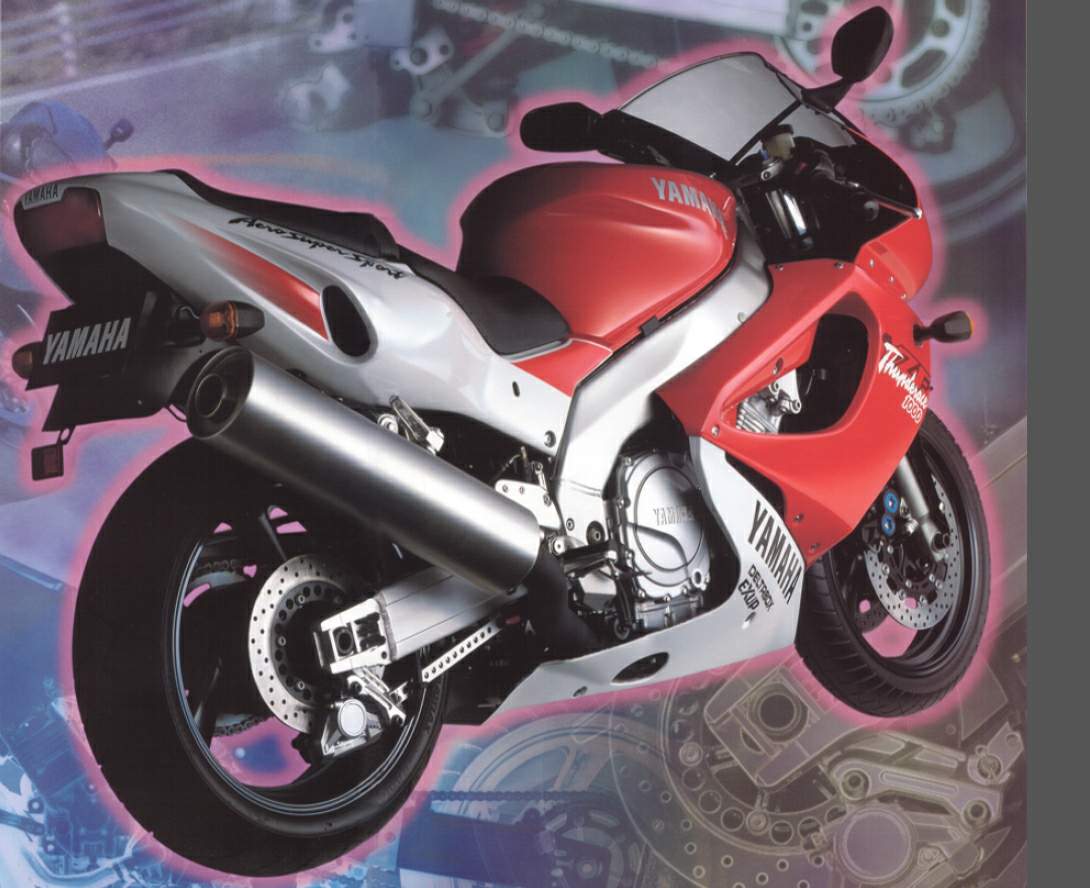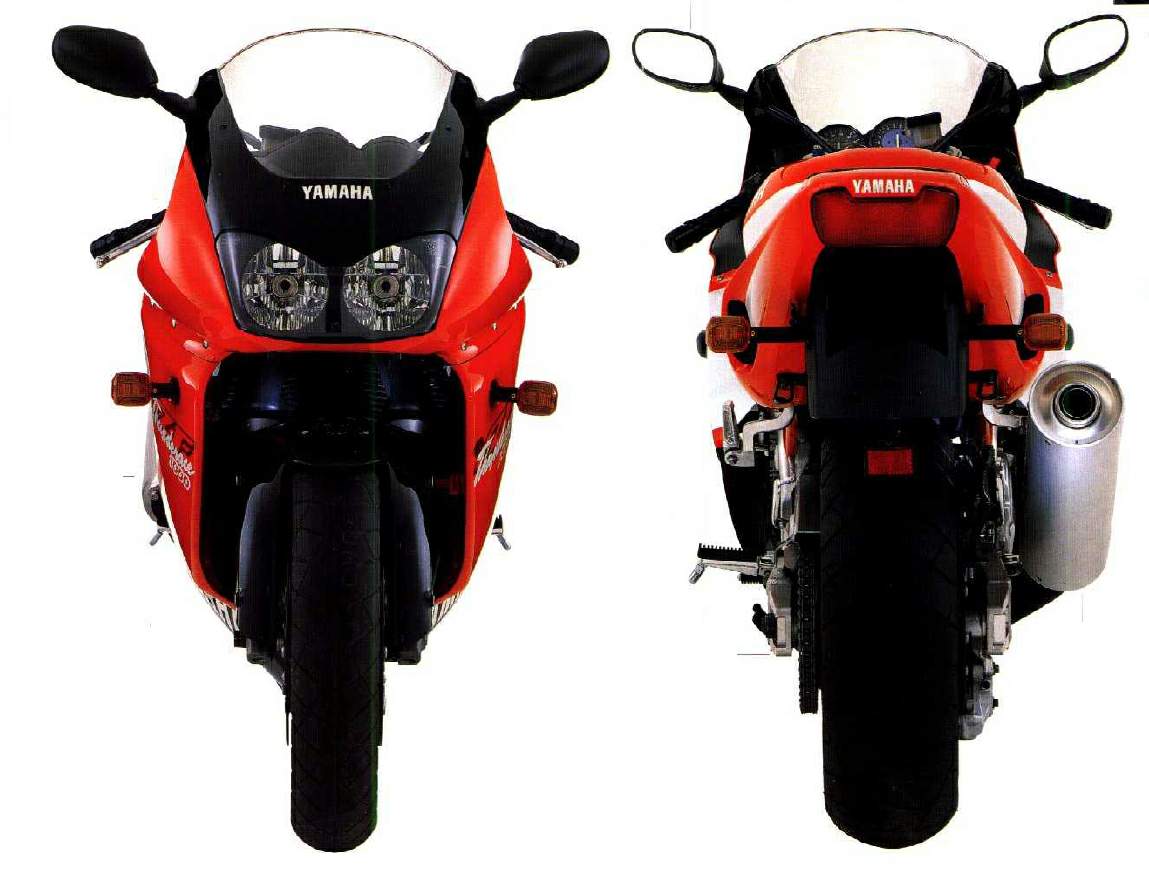The Thunderace is actually a bit of a mongrel, the 5-valve four-cylinder mill was spawned from an FZR1000 mold, and the frame was adapted from the vastly underrated YZF750R. The Genesis engine has undergone some changes aimed at improving mid-range power rather than the maximum output, which remains 145 bhp. The rotating mass of crankshaft and pistons have been lightened to improve throttle response, and new carburetors equipped with "Throttle Position Sensors" give the ignition some more data to help control the EXUP valve in the exhaust pipe. The engine spins freely and quickly, producing usable power from as low as 2000 rpm. At 3500 rpm it gets serious, and by 5000 the big Yamaha launches you into orbit, pulling cleanly with seamless, linear power all the way up to its 11,500 rpm redline.
Carburetion is good, with no flat spots or hesitation as the bike launches down the road to show 70 mph in first gear and 100 mph in second. All this power is delivered through a five speed gearbox that was still a bit tight but performed faultlessly throughout the test. Keep on redlining it in each of the gears and you'll find yourself heading for what feels like a world landspeed record with an indicated 170 mph showing on the dials flat out in top gear. Yamaha claims the fairing fitted to the Ace is the slipperiest ever worn by any of their street bikes, with a drag coefficient of only 0.29 -- very close to their YZR500 GP bike -- but it seems to do little to improve top speed, or fuel consumption for that matter. At the speeds the YZF is capable of the bike develops a thirst that will have you calling in at most of the gas stations along the journey; while managing a sensible 33 mpg at regular speeds, this drops to less than 23 mpg at speeds above 120 mph. Riding two-up, you might not even reach the next gas station.
The best strategy for avoiding frequent gas stops is to take to the backroads, since, capable though it is at long distances on the freeway, it is even better in squid territory. One of the objectives of the design team was to come in lighter than the FZR1000, and at 198 kilos (435 pounds), the Ace weighs in as the leanest litre class bike. This, coupled to the shorter wheelbase chassis (only 10mm more than the YZF750), has done wonders for the handling of the bike, which now cuts through the corners as quickly as one of the sports 600s. But it takes a little getting used to, as you are initially aware of the mass of the bike and the wide fuel tank makes it difficult to grip with your legs.

But put this out of your mind, flick the bike hard into a bend and it will track through without dramatics. Although steering might be judged a tad slower than the GSXR750 and the CBR900RR, it's more than adequate, and the bike feels very stable and settled. The Dunlop D204 SporT-Max IIs suit the bike well, giving good grip, sliding some under radical conditions, but without the feeling they will let go completely. Blitzing corners is made even more fun by the phenomenally powerful four-piston front brake calipers on 298mm rotors that are better than the YZF750's and Kawasaki ZX7R's binders. Leave the gas on a little too late and you'll still be okay, although mid-corner braking will have the bike wanting to stand up some and hustling it through the rest of the corner is more work than usual. The twin-pot brakes on the rear were great, providing heaps of feel and not cramping a foot throughout either of our tests.
It seems that the fashion for upside-down front forks is waning; the YZF comes equipped with conventional telescopic front forks. At 48 mm in diameter, they are plenty stiff for any street-legal tire. Full adjustment of bump and rebound damping, as well as the usual spring preload adjustment, is possible on both forks and rear shock. The suspension comes set up a little on the hard side, but can be softened out for relaxed rides over uneven surfaces. In fact the complete bike is remarkably relaxed for a 145 bhp sport machine, making lane splitting through the morning gridlock and the slow trickle through suburbia less of a pain than could be expected. Throttle and clutch are light, the brakes one-finger sensitive and the steering light even at low speeds.
One thing that did bother us was the vibrating mirrors; an important consideration on a bike like this if you intend to keep your licence. Steps have been taken to minimize the discomfort vibration may cause the rider, with large weights on the ends of the bars and rubber grips on the footrests. These work well, with the rider aware of the vibration, but not uncomfortably so. The seating position and relationship to the bars and pegs is quite comfortable, striking a good balance between the bike's intended roles of sports riding and touring.
THE REAL WORLD
Since the bike is in Italy and the Motorcycle Online test tracks and dyno are in Southern California, we can only estimate (with stopwatches and indicated speed readers -- not the best test equipment) the performance capabilities of the bike. But the combination of a powerhouse FZR1000 motor in a lightweight, nimble YZF750 frame has to be, well, pretty damn fast. Here are some Chianti-influenced numbers from our Italian correspondent.
We can only guess at the top speed, but the bike was running away from a 1994 Suzuki GSXR1100 whose speedometer was pegged at 280kph.
IMPRESSIONS:
Giulio Meccoci, Italian Desk:
This is a well-balanced bike with massive amounts of power.
The YZF chassis is perfectly capable of maintaining its
composure under the stress of an FZR1000 motor at full
throttle, yet it still makes for a very streetable bike. I
want one! Lanfranco:
I think I have finally found the total bike, the final weapon:
It combines the grace and power of an FZR1000 engine (made
even more powerful with a Yoshimura kit) and the first-rate
YZF750 chassis. This machine feels rock steady in 200km/h
sweepers, yet maintains superior driveability in the city
thanks to enormous amounts of torque. I'm very happy with the
way the bike turned out.


